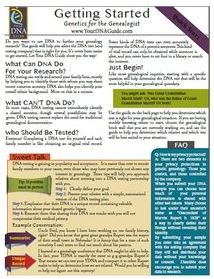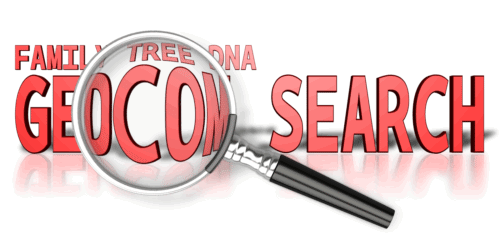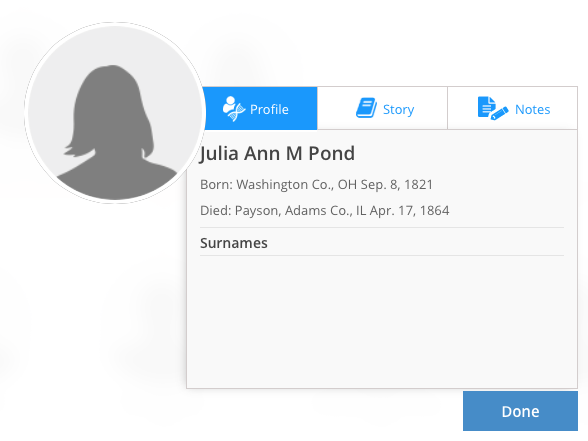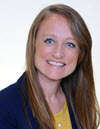by Lisa Cooke | Aug 1, 2016 | 01 What's New, DNA
“Are unassigned DNA test kits interchangeable? Does Diahan Southard do one-on-one DNA consultations for genealogy?” A listener asks, and we have the answers.
Simona recently wrote in with compliments and two questions for Diahan Southard. Here’s the Q&A, on more resources from Diahan AND whether DNA test kits from Family Tree DNA are interchangeable if they haven’t been use:
Q: “No one, I mean NO one makes DNA easier and more interesting than…your DNA expert Diahan does! I am curious as to what Diahan charges for phone or email consults regarding who to test for what.”
 A: Yes, I agree, Diahan Southard, Your DNA Guide and the resident Genealogy Gems genetics expert, is amazing! Diahan answers a lot of those initial question about who to test for what in her handy Getting Started: Genetics for the Genealogist Quick Guide (click to view/purchase). It’s very affordable and can give you inexpensive answers without needing to pay for one-on-one consultation.
A: Yes, I agree, Diahan Southard, Your DNA Guide and the resident Genealogy Gems genetics expert, is amazing! Diahan answers a lot of those initial question about who to test for what in her handy Getting Started: Genetics for the Genealogist Quick Guide (click to view/purchase). It’s very affordable and can give you inexpensive answers without needing to pay for one-on-one consultation.
That said, Diahan does offer DNA consultation services. She also teaches a series of how-to videos that’s, again, much more affordable than a consultation (and much more affordable than taking the wrong test or staring at your results afterward with NO idea what to do with them next). Like Simona says, Diahan demystifies DNA like no else does, and these video tutorials are no exception.
Genealogy Gems listeners get a discount on her video series. A year’s access to is regularly $39.95, but Gems listeners can click on a special link to get it for just $24.95. Click here to learn more.
Q: “I have 5 FamilyTree DNA kits on the counter. Are they all the same kits in the raw? I intended them for a Mtdna test, a Y test and 3 autosomal tests for various family folk. Can I switch tests and persons at this stage?”
A: Diahan says: “Yes, the Family Tree DNA kits she has can be used for any test, provided you correlate everything with the customer service team at FTDNA and get all the kit numbers changed to the appropriate tests.
Diahan Southard is definitely a valuable “GEM” here at Genealogy Gems. Whether you’re just starting to learn about DNA testing for genealogy research, or you’re trying to get the most out of your results, click here to read tons of free DNA how-tos and advice from Diahan. And thanks for sharing this post with your friends and genealogy buddies!This is so, so important as I know of too many women who have mistakenly used their husband’s YDNA kit number and had their sample run, which won’t produce any results. But FTDNA still ran the test, which means you still pay for it. So be EXTRA careful to make sure you have all of your ducks in a row.”
by Diahan Southard | Apr 27, 2016 | 01 What's New, DNA, Research Skills
Have you been wondering what’s up with the Y? After taking an autosomal DNA test, many genealogists want to know what next steps to take, and if YDNA can help further their research. YDNA, which can only be taken by males, may be able to bust additional brick walls in your family. DNA expert Diahan Southard is here to share 3 reasons to take a YDNA test–or have a male relative do so.
The Y chromosome DNA test, more affectionately referred to as the YDNA test, is the darling of the DNA testing industry. (At least, I think so.) In fact, of the three kinds of DNA tests, the YDNA is my favorite. Currently, the YDNA test is available at Family Tree DNA. Here’s their quick recap of what YDNA is:
“Y-DNA is what we call the sex chromosome “Y” that is passed from a father to his sons only, women do not receive a Y chromosome. Testing the Y chromosome allows for investigation into a male’s paternal family line and can help identify surname lines, living relatives whose Y chromosome is similar to yours, and ancient migration routes your paternal ancestors may have taken.”
At Family Tree DNA, there are four levels of YDNA testing available. 37 markers is the base level and a good place to start making connections. You can also increase your marker count to 67, 111, or if you’re a DNA expert, you can opt for the whopping 700 marker test. The good news is that you can start with the 37 marker test and have the option to upgrade to the larger test without needing to provide another sample.
YDNA has several excellent qualities that make it useful in many genealogical scenarios. Let’s look at three to give you a good start!
Use YDNA for Genealogy When…
1. You Have a Missing Father
All of us should be able to identify with this genealogical problem. Every line in your family history has this problem. Any ancestor whose father is currently unknown falls in this category. And YDNA can help.
The specific quality of YDNA that makes it so attractive in this case is its faithfulness in passing down its record generation after generation, without fail, without changing, from one man to the next. That means that any living male today has the same (or very similar) YDNA as every male in his direct paternal line, back 8, 10, 12+ generations.
Therefore every man’s YDNA is the clue that could lead you to discover that missing father. Usually what it takes is a match in the YDNA database with another descendant of your common ancestor. Ideally, this person knows something that you don’t about that missing father, and the two of you can work together to verify and extend your family history.
2. Your Relative is Worried About Privacy
While DNA testing has certainly entered a season of relative acceptance among genealogists, there are still many skeptics who wonder what the eventual ramifications of having your DNA tested might bring. While this is a subject that certainly deserves some attention, the YDNA is actually the easiest test to sell to a nervous relative.
The very qualities that make YDNA testing valuable, namely that every male descendant of a given ancestor will have the same YDNA, make it equally impossible to identify any particular individual uniquely. This means that the YDNA record that is created when a man takes a YDNA test cannot ever be traced back to him alone. That same record could have easily come from his brother, or 1st, or 5th cousin.
Similarly, the YDNA test results do not have a link to your health. The regions that are tested are generally parts that are not useful for determining any kind of personal health or trait information.
3. You Have a Surname Mix-up
One of the best applications of YDNA for genealogy comes when trying to disentangle the relationships of various men living in close proximity with other men of the same or similar surname. Having descendants of these men test their YDNA is like traveling back in time and conducting personal interviews of each of these men. It’s like saying, “Excuse me, Mr. Moffat? Is this neighbor of yours, Mr. Moffit, your uncle?” Wouldn’t you give anything for a chance to have that conversation? Well, YDNA testing gets you almost there. You might not be able to determine if they are uncle and nephew, but you will at least know if they are kin.
So what are you waiting for? If you have your own YDNA, go out and start the testing process. If you have been blessed instead with two X chromosomes, send this article over to your favorite male relative and let him know that he holds a very old, very valuable record in his DNA and you want to help him make use of it.
Learn More About DNA Test Options in This Free Video Class
Learn more about YDNA testing and the other types of DNA tests in this free video class, filmed live at RootsTech 2018! You’ll get answers to questions like:
- Which DNA test should I take?
- What will I get from the DNA test results?
- Will DNA testing help with genealogy?
If you or the relative you want to test wants more information about what DNA testing is all about, this is the perfect recap. And best of all, it includes helpful slides, graphics, and it’s all in plain English!
About the Author: Diahan Southard has worked with the Sorenson Molecular Genealogy Foundation, and has been in the genetic genealogy industry since it has been an industry. She holds a degree in Microbiology and her creative side helps her break the science up into delicious bite-sized pieces for you. She’s the author of a full series of DNA guides for genealogists.
Disclosure: This article contains affiliate links and Genealogy Gems will be compensated if you make a purchase after clicking on these links (at no additional cost to you). Thank you for supporting Genealogy Gems!
This article was originally published on April 27, 2016 and updated on May 2, 2019.
by Lisa Cooke | May 21, 2015 | 01 What's New, DNA, images, Trees
 While attending the NGS conference in beautiful St. Charles recently–during a rare calm moment at the Genealogy Gems booth–I slipped over to the Family Tree DNA booth to talk to Taylor Trusty, the FTDNA product manager. There’s been a question on my mind about Family Tree DNA privacy since my last post about them: why are we seeing “private trees” when we use the new global GEDCOM search?
While attending the NGS conference in beautiful St. Charles recently–during a rare calm moment at the Genealogy Gems booth–I slipped over to the Family Tree DNA booth to talk to Taylor Trusty, the FTDNA product manager. There’s been a question on my mind about Family Tree DNA privacy since my last post about them: why are we seeing “private trees” when we use the new global GEDCOM search?
He explained that one of the main reasons is due to the fact that FTDNA has a game plan, and they want to make sure that their privacy settings are going to be able to accommodate these upcoming integrations. So, they have erred on the conservative side. Because the consent form that you signed when you were tested indicated that you would be showing your information to your “matches,” FTDNA is hesitant to show your information to your non-matches, like what happens in the global search. So your name will not show up attached to your pedigree chart in the global search (even to your matches!) unless you change your privacy settings.
 If you want to change this, click your name in the upper right corner, then click Account Settings, Click on the Genealogy tab and change “Deceased people born in the last 100 years” to Public. Taylor is promising that an email will go out at the end of June encouraging everyone to do just this.
If you want to change this, click your name in the upper right corner, then click Account Settings, Click on the Genealogy tab and change “Deceased people born in the last 100 years” to Public. Taylor is promising that an email will go out at the end of June encouraging everyone to do just this.
 For more help using FTDNA, check out my quick guide, Understanding Family Tree DNA, available on its own or as part of my DNA super bundle (click on the image to the left to read about the bundle). This inexpensive laminated guide will help you save time and frustration while helping you get the most out of your investment in DNA for genealogy.
For more help using FTDNA, check out my quick guide, Understanding Family Tree DNA, available on its own or as part of my DNA super bundle (click on the image to the left to read about the bundle). This inexpensive laminated guide will help you save time and frustration while helping you get the most out of your investment in DNA for genealogy.
As always, if you’re ready for a personal consultation with me, you can reach me through my website, YourDNAGuide.com. I help people decide what testing is right for their family history questions–and I help them make the most of their results.
by Lisa Cooke | May 11, 2015 | 01 What's New, DNA, images, Records & databases, Technology
 Family Tree DNA (FTDNA) has some of my very favorite genetic tools to help you make connections with your DNA matches when you can’t immediately find a genealogical connection, but it’s no secret that their genealogy tools leave much to be desired. However, their latest genealogy tool has promise: if certain conditions are met, you will be able to see whether any descendant of one of your ancestors has taken a DNA test!
Family Tree DNA (FTDNA) has some of my very favorite genetic tools to help you make connections with your DNA matches when you can’t immediately find a genealogical connection, but it’s no secret that their genealogy tools leave much to be desired. However, their latest genealogy tool has promise: if certain conditions are met, you will be able to see whether any descendant of one of your ancestors has taken a DNA test!
For quite some time now FTDNA has allowed you to enter your genealogical surnames and locations into your account and list your earliest known paternal and maternal line ancestors. The latter is displayed for your YDNA and mtDNA matches to see and the former for your autosomal DNA matches to see. As a bonus, if one of your autosomal matches shares an inputted surname, FTDNA will bold that surname (or location) for you in the “Ancestral Surnames” column of your match page.
A few months ago they upgraded their pedigree tool for uploading a GEDCOM into your account. This GEDCOM does not in any way interact with your DNA match list or results; it is just provided as a resource to your matches. The pedigree tool itself is clumsy at best, but at least it is searchable and can give you a head start when looking for matches. It would be really nice if FTDNA could scrape all the surnames and locations from your GEDCOM and use that to populate your Ancestral Surnames field, but it does not.
The latest addition to FTDNA’s mediocre genealogy offerings is the ability to search all of the uploaded pedigree information in the FTDNA database. The best part about this feature is that it is not limited to searching just your DNA matches. This means you can see if any descendant of one of your ancestors has taken a DNA test! This is great news!
Of course, you see the immediate problem: if the cousin of interest hasn’t uploaded a GEDCOM, you still won’t be able to find them. And, of course, the usefulness of the information is completely dependent on other people’s genealogical sleuthing skills. But still, this can be a useful tool.
I tried using this tool to find out if there were other descendants of my ancestors Julia Pond and Austin Tilton who had tested. I have one DNA match who descends from this couple and I am fairly certain this is our connection. I wanted to see if there were others out there who were also descendants of this couple. I started with just a search for “Julia Pond” and got 37 results. I then used the advanced search feature to add her birth year “1821” and “Ohio.”
There were two matches. My family tree, and another belonging to Katie. It was frustrating that I couldn’t see right away if Katie was also a DNA match. But in the Advanced search I can ask to see only DNA matches, and repeat the search. Katie disappeared. By doing this I learned that Katie is descendant of Julia and Austin, but she and I don’t share enough DNA to be considered related. This makes sense, since descendants of this couple would be my 4th cousins at best, and I know that I will only genetically match about half of my fourth cousins. I can now contact my DNA match that lists Julia and Austin on his pedigree and ask him if Katie shows up on his match list. Perhaps they share some DNA that I do not.
Speaking of that DNA match of mine: why wasn’t he listed in my search results for Julia Pond? Well, it turns out that in his pedigree she is listed as born in 1821 from OH, and my search said Ohio. Ah. The search function is not catching those kinds of differences. So be careful.

When implemented properly, this tool can help you collect all of the descendants of a particular ancestor so you can learn more about what DNA you inherited from whom, and further your genealogical efforts.
Are you ready to get started? If you’re new to genetic genealogy, the first thing to do is acknowledge you may face some unexpected discoveries. If you’re not willing to chance some surprises on your family tree, don’t pursue it yet. Next, evaluate FTDNA (or other DNA companies) for yourself. If you decide to get started, your first step should be to upload your own GEDCOM, and make it public. Don’t feel like you have to put everything you know in this GEDCOM, just what you are certain of and feel confident sharing. To make it public, go into your Account Settings, and agree to share your Basic Profile.
 After this Family Tree DNA review, if you’re ready to explore what DNA can do for YOUR genealogy, why not explore how I can help you do it? My quick guides on genetic genealogy include a guide specifically for those who test at Family Tree DNA.
After this Family Tree DNA review, if you’re ready to explore what DNA can do for YOUR genealogy, why not explore how I can help you do it? My quick guides on genetic genealogy include a guide specifically for those who test at Family Tree DNA.
You can also hire me for an individual consultation to make sure you’re doing the right DNA tests with the right relatives to answer your burning genealogy questions. (Testing the wrong people or DNA type can be a very expensive mistake!)
by Lisa Cooke | Jan 7, 2014 | 01 What's New, Ancestry, DNA, Family History Podcast, FamilySearch, Organization, Photographs

No episode! But lots of good updates. Keep reading….
UNLUCKY Episode 13: Genetic Genealogy and Photo Sharing
Episode 13 of the original podcast reviewed genetic genealogy and photo sharing products that are either now longer offered or are outdated. This episode is not being republished with the series.
Fortunately, lots of advances have been made in both genetic genealogy services and photo sharing and tagging, and we’ve got lots of current resources for you.
Genetic Genealogy (DNA)
Start here where you’ll find answers to common questions, a free introductory video, and additional DNA resources
Next, listen to my interview with Dr. Turi King, who used DNA to identify King Richard III. That interview is on my Premium Podcast (available by subscription) and talks about what DNA can tell us–and what it can’t.
Another interview you might enjoy is with Bennett Greenspan from Family Tree DNA, featured in Premium Podcast Episode 92.
 (Not a Premium Member? Check out all the great membership benefits–including members-only premium podcast episodes, full access to the premium podcast archive for an entire year, video recordings of some of my most popular classes and even premium videos that teach you some of the most important skills for 21-st century genealogists.)
(Not a Premium Member? Check out all the great membership benefits–including members-only premium podcast episodes, full access to the premium podcast archive for an entire year, video recordings of some of my most popular classes and even premium videos that teach you some of the most important skills for 21-st century genealogists.)
Free Photo Sharing Resources
Flickr
Photobucket
In addition, remember that Ancestry.com, FamilySearch.org, MyHeritage.com and other genealogy sites have excellent photo-sharing services for those who don’t mind sharing their images with the public.
 A: Yes, I agree, Diahan Southard, Your DNA Guide and the resident Genealogy Gems genetics expert, is amazing! Diahan answers a lot of those initial question about who to test for what in her handy Getting Started: Genetics for the Genealogist Quick Guide (click to view/purchase). It’s very affordable and can give you inexpensive answers without needing to pay for one-on-one consultation.
A: Yes, I agree, Diahan Southard, Your DNA Guide and the resident Genealogy Gems genetics expert, is amazing! Diahan answers a lot of those initial question about who to test for what in her handy Getting Started: Genetics for the Genealogist Quick Guide (click to view/purchase). It’s very affordable and can give you inexpensive answers without needing to pay for one-on-one consultation.










 (Not a Premium Member?
(Not a Premium Member?